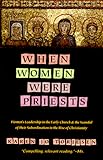Originally written in the late ’90s regarding the reading list of a truly fascinating anthropology class. The papers are extremely light — basically just some quick review and discussion questions. I include them here mostly because the books were excellent and well worth reading for thoughtful perspectives on women’s roles in a variety of religions.
Women in the Qur’an, Traditions, and Interpretation
by Barbara Freyer Stowasser [paper I]
I found this week’s readings (the initial chapters of the book) fascinating. However, I was ultimately left with a feeling of dismay, due to perceiving the same pattern repeated again and again in the religions we are (admittedly somewhat cursorily) exploring.
The pattern seems to go as follows: religious texts are written, where men and women are seen as, if not equals, at least as partners or as complementary individuals. However, somewhere along the line, women become the despised and abused scapegoat for all man’s inequities and perceived injustices, and as a consequence are re-situated into the category of dependent, subordinate, or even simply property.
Thus we have Hinduism with its view of women as baby-making dependents of men, who are considered their lords and gods; Judaism with its view of women as the objects through which a man has a large and prosperous family, with (initially) as many women as he can marry, much the same way his rams and bulls do within his flocks; Christianity with women as the architects of man’s fall from grace, as well as the guilty agents of original sin; and Islam with its view of women as deceitful partners of Iblis, or Satan, and cursed by god with moral, mental, and physical deficiency.
I guess if I had to ask a question in class it would run something like this: Why does this horrible metamorphosis happen? Why do men do this to women? Why did men have to work so hard, to create so many institutions, that were partially dedicated to justifying and enforcing this crushing burden on women? What is so terrible, what do they so fear, that women — and by extension sometimes sexuality and even genitalia — are viewed with such horror and loathing?
To my experience, sex has been mostly a pleasurable experience. How has this pleasure been so subverted? Why are women so firmly tied in the male mind to both sexuality and evil? It is men who are supposedly unable to contain or control themselves in response to women — so how can they thus justify the oppression and obliteration of women and women’s identities?
Unfortunately, this leads me to a final question, one for which (like the others) I do not yet have an answer. True, most religious texts seem to have some basis of belief in women as individual and worthwhile beings. But, considering the crushing weight of millennia of hateful and repugnant thought on the nature of women — thought which frequently dominates religious exegesis more strongly than the original texts — is there really any place for women in any of the larger and more institutionalized religions?
In fact, is there really any possibility of reclaiming anything of value to women from these antiquated and obsolete modes of thought? Or would it be healthier, in the long run, for women to simply and completely deny the applicability of institutionalized religion to their lives?
Women in the Qur’an, Traditions, and Interpretation
by Barbara Freyer Stowasser [paper II]
This week’s readings finished the last chapters of Women in the Qur’an, Traditions, and Interpretation. In it, Stowasser notes the lack of women or naming of women in the Qur’an, but also notes the reverence that the few mentioned are frequently given. She then examines several (possibly all) the women the Qur’an mentions, both ‘good’ women as well as ‘bad.’
What makes her book a fascinating read is her various interpretations of each woman’s story. She gives a straightforward Qur’anic version of the tale, then adds both medieval and modern interpretations of the moralities and teachings each sura (or Qur’anic verse) embodies for the Islamic community. Thus one can track a (heavily generalizing on my part) apparently chronologically linked trend towards conservatism in the teachings concerning women today.
The question I was left with, after reading this book, wasn’t so much about the women of the suras so much as about the Qur’an itself, and the Qur’anic community which it informs. In order for teachings about women to change, to become more conservative and restrictive, there must be a privileged class of individuals who have some exclusivity in the reading and interpretation of the Qur’an. Yet there are inexpensive, mass-produced, printed versions of the Qur’an available in the world today, just as there are of the Bible.
Therefore I am left with a puzzling thought. Apparently there is access to the Qur’an available to all, through these mass-produced editions — and yet many of the Qur’anic interpretations of proper behavior for women (like those of the Bible) seem to be growing steadily more conservative.
The only way I can see for this to happen is if people aren’t actually reading the holy books, but are instead assuming as correct the interpretations of others… and my question becomes, ‘Why do people let others think for them — especially when it harms them to do so?’
Other Excellent & Recommended Books from this Course
 Fundamentalism and Gender
Fundamentalism and Gender
edited by John Stratton Hawley
 When Women Were Priests: Women’s Leadership in the Early Church and the Scandal of Their Subordination in the Rise of Christianity
When Women Were Priests: Women’s Leadership in the Early Church and the Scandal of Their Subordination in the Rise of Christianity
by Karen Jo Torjesen


